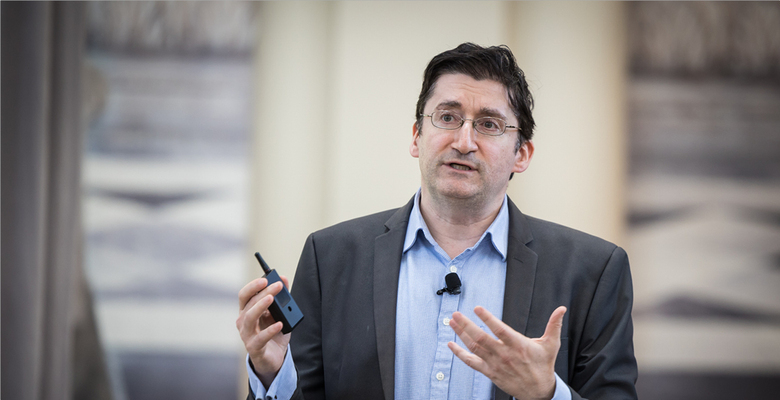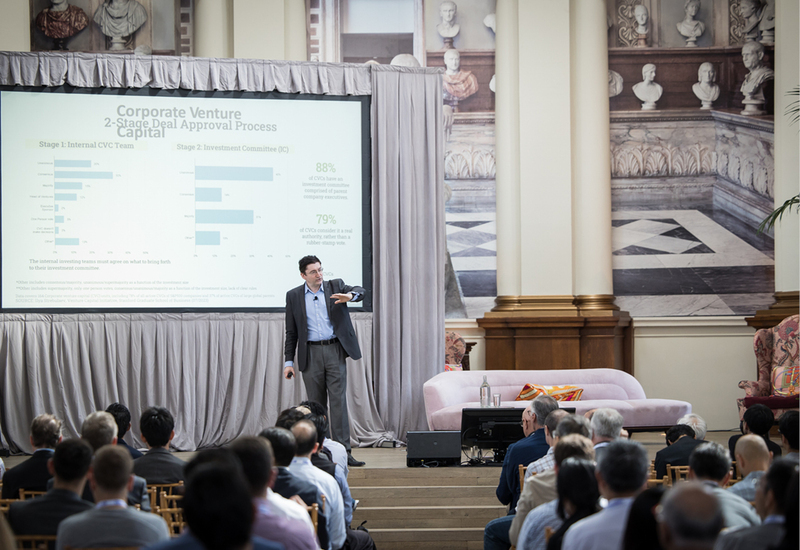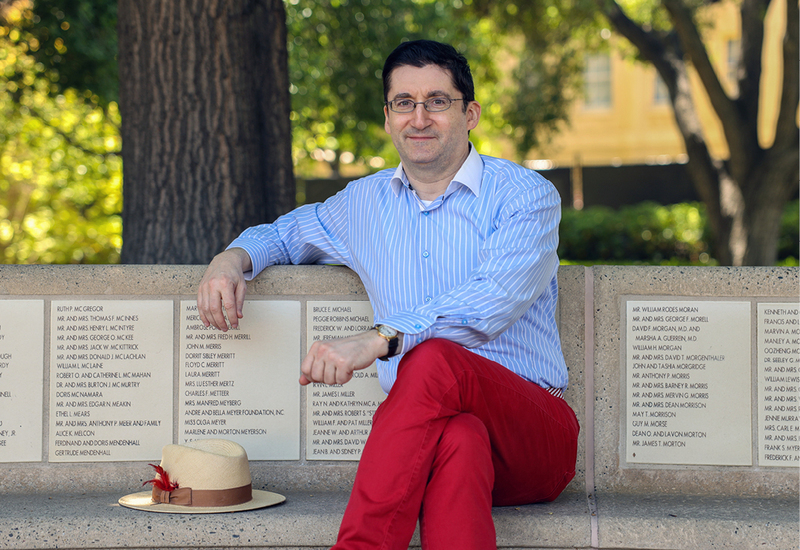
In this interview with the head editor of Kommersant UK, Russian-American Stanford University Professor and economist Ilya Strebulaev, an expert in corporate and venture capital (VC), explains why VC is the future and tells us about his new online course for founders and investors.
You are a Stanford professor, the only Russian scientist to have been accorded that honour for life. How did you achieve this and what privileges does your status entail?
Stanford Business School is a part of Stanford University. It’s true that, over the entire, almost hundred-year existence of the business school, I am the first ever professor from the former Soviet Union and also the first from that region to have received the lifelong title of Full Professor. This gives me a very pleasant feeling and when I talk to a Russian audience, I always bring it up. In all, at the business school, there are approximately 130 professors of which 70 are for life (including me, the only Russian), while others have only joined us recently. I do have Russian-speaking colleagues as, in the wider University, there are far more Russophone professors. Before me, there were maths and physics professors from the Soviet Union. Stanford University has no right to fire these professors for life, whatever happens. This is probably the main privilege, and there's an interesting story behind why it came to be this way in American higher education. As professors for life can’t be fired, it’s very hard to get these titles. To receive one, you need to virtually prove that you are the best in the world in your narrow specialised field; a global leader in a particular area and a potential Nobel Laureate. I received this title for my research in the field of corporate finance. An additional, and very important advantage of this status is the students who come to work with you. It’s well-known that many prefer to work with famous Full Professors. There are three components to a professor's activities at Stanford; teaching, research and also commercialisation beyond the university walls, helping the institution to earn. These three pillars are in close interplay with each other.

You’re a Moscow State University (MSU) graduate. How did you get into the London Business School? What memories has your London Alma Mater left with you?
After graduating in economics at MSU, I got a master’s degree at the New Economic School (NES) in Moscow and many of my student colleagues there went on to do PhDs in economics abroad. I became interested in finance. Various chance occurrences made me wonder how people make financial decisions. While my colleagues were trying to get into American universities to do PhDs in economics, I decided to get onto the best finance PhD programme I could find. The London Business School (LBS) clearly had the most interesting programme in this area, as it still has now. The choice was obvious. Many of their alumni are very impressive. After the LBS I came to Stanford. My five years at the LBS were unique from the perspective of the skills I received, the work done and how I was able to interact with professors and students.
What were your impressions of London when you moved here?
It was 1999 and, in some ways, London was exactly the same as it is now, while, in others, it’s a little different. Since I had visited the city several times previously, my first impressions were formed before I moved here. I had always admired the English capital and I knew that it would be a comfortable and interesting place to live. This is why my first impressions of that time in 1999 are not of London itself but of beginning active collaboration with my colleagues and professors at the business school.
Can you compare the different approaches to education in Moscow and London?
It’s difficult for me to compare as I didn’t defend a thesis in Moscow or conduct postgraduate or doctoral studies there. At the LBS I did a PhD in finance, while at the MSU I was doing a baccalaureate degree. As my grandmother used to say, that wasn’t quite the same kettle of fish. Then I studied for an MA at the NES [Moscow’s New Economic School], but this was still just study. You have to understand that in order to get a PhD, you don’t so much have to study as conduct scientific research. In my first year at the LBS, everything was very intensive. First of all, there were very small classes; fewer than ten people. Secondly, there was much more independent work, homework and projects and thirdly it was very advanced material. People there study the latest scientific advances in the field. Courses largely consist of taking around 20 of the most advanced articles published in the last two or three years, reading and then analysing them, making comments, replicating the results and imitating them etc. I spent perhaps 90% of my time at the LBS on scientific work.
How did you manage to achieve such unbelievable results in your scientific work? Did you work day and night?
My success wasn't a product of hard work, but rather came from one of my primary skills; the capacity to look at longstanding questions, pondered by many for years, from a wholly original perspective. In other words, I can approach a well-known question from a totally new angle. On the one hand, you need to know the material well to do this, but on the other, this doesn’t mean spending a lot of time. I’d say that I used to work six, seven, eight, nine or ten hours a day, but I wasn’t dying of overwork. I also managed to enjoy London over those five years. For example, I went to all the opera performances at Covent Garden and all the new exhibitions at the National Gallery. I’m fascinated by art and opera.
You were an innovator. Did you encounter any resistance from the professors?
It’s not like that in my field. All the professors I worked with at the LBS actively supported me. They took me very seriously from the first day and that’s the most important thing. They didn’t treat me as a student, but rather as a colleague. Naturally, they criticised me and looked for the weak points in my approach, but this wasn’t resistance. It was genuine collegial science.
Now you are a professor yourself and you teach at Stanford. How are students at the university today different from the pre and post-graduate students of your time?
There are two types of students. The first is PhD students like I was at London Business School. I’d say that the PhD students who are currently working with me, or at least the best of them, are not very different from me 25 years ago. The world has changed immensely; when I was doing a PhD, the best outcome of a PhD programme was the opportunity to become a professor and the best students went to do this at different universities, not just at Stanford. Today’s PhD students, especially in the area of finance, have many other attractive opportunities. For example, one of my students, who could have become a professor, decided to go to LinkedIn and they became a not-insignificant figure there straight away. Nowadays, the university isn’t just competing with other academic institutions, but also with the real world. The second type of student is those doing MBAs. They come to Stanford for two years. (At the LBS there is also a two-year programme which is renowned in Europe). After those two years, they go out into the real world which they never stop living in. They have completely different tasks before them and it’s hard for me to compare them with the MBA students in London, as I didn’t have much to do with them when I was at the LBS, with the exception of a few friends. But over the last 20 years, students overall, in my view, have become better, they are more demanding and better informed. The modern world has made it easy to quickly find out everything that is happening internationally. Each year, I find my classes at Stanford on venture capital and private equity more and more interesting to teach, because the questions that students ask, the topics that we discuss and the depth of the material are always reaching new levels.
What is the percentage of women amongst your students?
On PhD programmes, there really are more young men than women, roughly at a 75/25 proportion. In MBA programmes, it’s 50/50.
Is it possible to listen to your lectures online and receive a diploma on completing the course?
To listen to my lectures in English or complete a full course, you have to be admitted to Stanford. But, as I have already said, any professor is free to pursue commercial activity outside the university and I often work as a consultant for major international companies, funds and investors in the area of venture capital and private equity. I also hold separate courses for major companies and funds. These are mainly about venture capital. In Russian, a New Economy Investors Club (NEIC) course is available, which my colleague and I have created. We took my Stanford course on venture capital, which is one of the most popular in the business school, for which more than 200 MBA and PhD students enrolled this autumn, and we translated it into Russian. This was not straightforward because some of the terminology hadn’t even previously been established in Russian, however, it covers virtually everything you need to know about venture, from the earliest stages of investment to a more advanced level. How should you appraise a startup founder and their business model, what are the right questions to ask and what red flags should make you pause? How should you appraise startups which have already raised a little money, and what should you do if you want to invest in startups at a later stage? How much do startups cost? What contract conditions are more important for you when investing in a startup? Besides this, we also cover what investors should do if they really want to invest in venture funds. These are only a few of the questions which are discussed.
As I understand it, this course isn’t just useful for potential investors but also for founders who want to understand how everything works.
That’s absolutely right. It’s interesting that after doing the venture capital course at Stanford, no fewer than half the students become company founders. Many of them raise venture funding, some companies go public etc. These skills are important for those who want to found a startup because founders should raise money and work proactively with VC investors, who are very different from ordinary investors who put their money onto the public market. If a founder doesn’t understand how to work with venture investors and how these investors will appraise them then they have far fewer chances of making their company successful. This is why the course is intended both for investors and founders who either want to potentially raise angel or venture funding or have already done so. We created a Russian language online course two or three years ago, during the pandemic and it became very popular, both for investors and certain founders.
How much does this training cost?
There are two pricing options. A recording of all the lectures costs £1,700, while a complete course costs £15,000. This includes lectures and seminars with me, Viktor Orlovski and Anna Dvornikova, with individual analysis of each case. The cost of similar courses at business schools is several times greater.
NEIC is offering Kommersant UK readers a chance to begin training on an online venture capital course right now. On registering before February 15 2024, the first six lectures can be heard for free!
How have the events of the last few years (economic crises and geopolitical changes) affected the VC investment market? Has a venture capital winter truly come?
I think that the VC winter exists for those who haven’t done my course as they don’t know the right way to invest and raise venture capital money. The venture capital winter is a relative concept. In my view, now is for many reasons the best time for investment in the world of innovation, not only in the VC field but also in open markets. Secondly, extraordinary technological development is underway, but this is not enough. Unprecedentedly, this technological development is occurring across virtually all industries. Now everyone knows about ChatGPT. This is different from previous technology as people in almost any industry can use ChatGPT and improve their productivity and effectiveness. This means that its influence will be felt across virtually all sectors. And there are many such innovations. They are constantly appearing. Many of my former students at Stanford, with whom I work, are launching their own startups or venture funds and they’re not experiencing a VC winter. What’s more, I can distinctly see that over the next five to seven years an incredible spurt of new tech businesses will occur. Many of these companies will become future trillion-dollar startups. Everyone knows the great innovators Musk and Jobs, but try to name me another couple of similar names. I think that there’ll be many more of them in the next five to seven years. Major companies will be able to significantly strengthen their positions in their markets and enter new ones with the help of phenomenal new startups and venture investments or, otherwise, they will lose their dominant positions. My prediction is based on my research; up to half of currently existing major companies will disappear in the next 15 years as they are not able to adapt and, for various reasons, they have been unable to work with the VC world, which is now taking an increasingly prominent position.

Which country now has the greatest potential for investing in early-stage startups? If we compare investment opportunities on the US and UK markets, where are conditions better for startuppers and investors?
Historically the situation has been different in Britain, and not in a good way. In the US there are many professional, highly qualified investors such as university endowment foundations, pension funds and large companies investing in innovation and venture capital. Since the 1970s, this has ensured a steady flow of new capital into the US VC market. For a range of reasons, this has never happened in Britain, even in the last few years. This is why there is no British Google, Facebook, Airbnb etc. But actually, in Britain, there are some success stories. For instance, one of the most well-known British startups is DeepMind. This startup demonstrates the quality of human capital in the UK and the advanced level of technological development. But it also shows us the undeveloped state of the British venture capital market, as DeepMind didn’t become an independent public company. Instead, it was bought by Google. Top American companies buy outstanding British startups, of which DeepMind is a prominent, but by no means unique example. Britain still lacks a complete venture capital chain, although I see a positive trend in bio- and fintech. Here, as in continental Europe, there is still a poor understanding of venture capital and venture innovation, which greatly differs from standard innovation in an established company or the state sector. In my view, Britain has great potential, but for this to be fulfilled there must be more understanding of what VC is and how it needs to be served up. This understanding is essential for startup founders, investors, the heads of major companies and civil servants alike.
What sets innovations in venture capital apart?
There are two types of innovations. The first is marginal or incremental innovation when an existing product or service is slightly improved. Its consumers, business models and technological principles remain fundamentally unchanged. For example, Gillette develops men’s razors. This is an example of incremental innovation. The company spends hundreds of millions of dollars inventing a new razor. At Procter & Gamble, which owns Gillette, there are more PhDs than at Stanford, Harvard and the Massachusetts Institute of Technology (MIT) combined. Every five years, Intel builds a new semiconductor fabrication plant, or ‘fab’. It’s hard to believe that an increment can cost 20, 30 or 50 million dollars, but this is the case as it does not change the natures of the consumers, their interaction with the company or the business model.
The second type is disruptive innovation. Either they transform a business model, the consumer changes, their interactions with the company might shift, or all three of these things may occur concurrently. For example, the iPhone is a disruptive innovation which changed the business model of its company. Apple no longer sells telephones. Instead, it sells telephone-related services. Zoom, (a company founded by Stanford graduate Eric Yuan), is a radical innovation and now everyone can use this development, not only major companies. In the virtual video messaging market, Zoom has a different business model from its predecessors. Radical innovation requires a completely different approach and VC investors have found it. This approach is so important that I have already been researching it for 20 years, finding out how venture capitalists make decisions when it comes to radical innovation. I have even written a book on the subject: The Venture Mindset. It will be published in English in May 2024 both in the US and Britain (an electronic version is already available on Amazon). Soon a Russian translation will also come out. The best venture specialists have a completely different mindset. The book describes their decision-making process step by step and explains how we can all learn this art. It’s my first book in English, by the way. I wrote my first book, Let’s Play Economics, in Russian in the 1990s. It was the first book published in Russia dedicated to behavioural economics and finance.
What do you think of the use of Artificial Intelligence to appraise startups?
Many venture capitalists are beginning to use AI, which has various models for the assessment of startups and their founders. It’s still too early to say which of these will be successful, but I don’t doubt that the application of AI will be a radical innovation for the venture sector itself. But this must be researched. In my courses, we will discuss in more detail how AI can be used in all VC business processes.
Do you use AI yourself?
Naturally, every day. Conducting scientific research constantly involves using AI, it is part of the scientific process. What’s more, when we use these developments, we don’t call them artificial intelligence (this concept is too vague). Instead, we mention specific models and applications.






